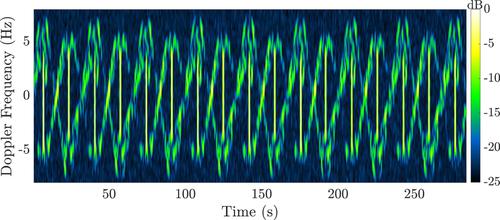当前位置:
X-MOL 学术
›
IET Radar Sonar Navig.
›
论文详情
Our official English website, www.x-mol.net, welcomes your feedback! (Note: you will need to create a separate account there.)
Long baseline bistatic radar imaging of tumbling space objects for enhancing space domain awareness
IET Radar Sonar and Navigation ( IF 1.7 ) Pub Date : 2023-12-19 , DOI: 10.1049/rsn2.12511 Alexander Serrano 1 , Alexander Kobsa 1 , Faruk Uysal 2 , Delphine Cerutti‐Maori 3 , Selenia Ghio 4 , Andrew Kintz 1 , Robert L. Morrison 1 , Sarah Welch 1 , Philip van Dorp 2 , Gregory Hogan 1 , Simon Garrington 5 , Cees Bassa 6 , Chris Saunders 7 , Marco Martorella 8 , Miguel Caro Cuenca 2 , Isaac Lowe 9
IET Radar Sonar and Navigation ( IF 1.7 ) Pub Date : 2023-12-19 , DOI: 10.1049/rsn2.12511 Alexander Serrano 1 , Alexander Kobsa 1 , Faruk Uysal 2 , Delphine Cerutti‐Maori 3 , Selenia Ghio 4 , Andrew Kintz 1 , Robert L. Morrison 1 , Sarah Welch 1 , Philip van Dorp 2 , Gregory Hogan 1 , Simon Garrington 5 , Cees Bassa 6 , Chris Saunders 7 , Marco Martorella 8 , Miguel Caro Cuenca 2 , Isaac Lowe 9
Affiliation

|
Long baseline bistatic radar systems herald enhanced sensitivity and metric accuracy for space objects in geosynchronous orbits and beyond. Radio telescopes are ideal participants in such a system; in particular, they often feature large apertures with low-noise temperatures and have stable, synchronised clocks. Pairing radio telescopes with high-power radars creates new methodologies for Space Domain Awareness. This paper describes long baseline bistatic measurements using the Millstone Hill Radar in the USA, the Tracking and Imaging Radar in Germany, multiple receivers of the enhanced multi-element remotely linked interferometer network array in the United Kingdom, and the Westerbork Synthesis Radio Telescope in the Netherlands. The authors, a Research Task Group formed by the NATO Science and Technology Organisation Sensors and Electronic Technology Panel (SET-293), performed novel bistatic and monostatic radar imaging experiments with real on-orbit tumbling rocket bodies. These experiments on tumbling objects at near-geosynchronous orbits highlight successful demonstrations of advanced bistatic Doppler characterisation across diverse imaging geometries. Specialised Doppler processing on tumbling targets, such as the Doppler superpulse algorithm, enables high-fidelity rotation period estimation and determination of minimum target size.
中文翻译:

翻滚空间物体的长基线双基地雷达成像,增强空间域感知
长基线双基地雷达系统预示着地球同步轨道及更远空间物体的灵敏度和测量精度得到提高。射电望远镜是此类系统的理想参与者。特别是,它们通常具有大孔径、低噪声温度和稳定、同步的时钟。射电望远镜与高功率雷达的结合为空间域感知创造了新的方法。本文介绍了使用美国的 Millstone Hill 雷达、德国的跟踪和成像雷达、英国的增强型多元件远程链接干涉仪网络阵列的多个接收器以及英国的 Westerbork 合成射电望远镜进行的长基线双基地测量。荷兰。由北约科学技术组织传感器和电子技术小组(SET-293)组成的研究任务组的作者们利用真实的在轨翻滚火箭体进行了新颖的双基地和单基地雷达成像实验。这些在近地球同步轨道上翻滚物体的实验强调了跨不同成像几何形状的先进双基地多普勒表征的成功演示。对翻滚目标进行专门的多普勒处理,例如多普勒超脉冲算法,可以实现高保真旋转周期估计和最小目标尺寸的确定。
更新日期:2023-12-19
中文翻译:

翻滚空间物体的长基线双基地雷达成像,增强空间域感知
长基线双基地雷达系统预示着地球同步轨道及更远空间物体的灵敏度和测量精度得到提高。射电望远镜是此类系统的理想参与者。特别是,它们通常具有大孔径、低噪声温度和稳定、同步的时钟。射电望远镜与高功率雷达的结合为空间域感知创造了新的方法。本文介绍了使用美国的 Millstone Hill 雷达、德国的跟踪和成像雷达、英国的增强型多元件远程链接干涉仪网络阵列的多个接收器以及英国的 Westerbork 合成射电望远镜进行的长基线双基地测量。荷兰。由北约科学技术组织传感器和电子技术小组(SET-293)组成的研究任务组的作者们利用真实的在轨翻滚火箭体进行了新颖的双基地和单基地雷达成像实验。这些在近地球同步轨道上翻滚物体的实验强调了跨不同成像几何形状的先进双基地多普勒表征的成功演示。对翻滚目标进行专门的多普勒处理,例如多普勒超脉冲算法,可以实现高保真旋转周期估计和最小目标尺寸的确定。



























 京公网安备 11010802027423号
京公网安备 11010802027423号